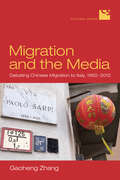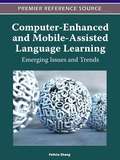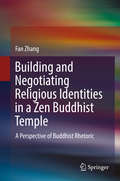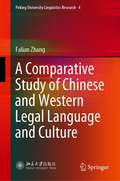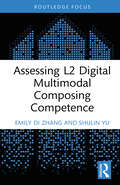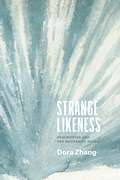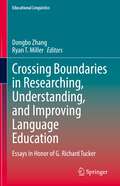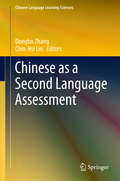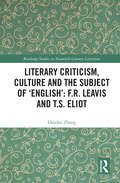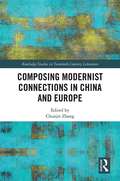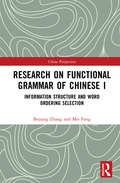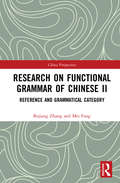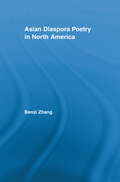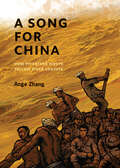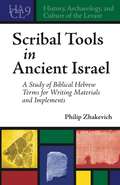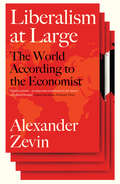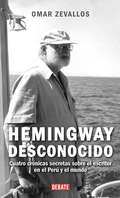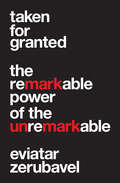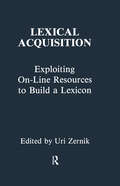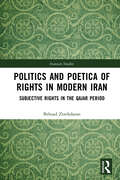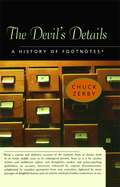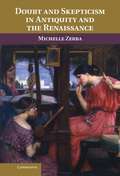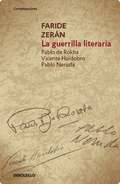- Table View
- List View
Migration and the Media: Debating Chinese Migration to Italy, 1992–2012 (Cultural Spaces)
by Gaoheng ZhangThe first book to analyze cultural dynamics of Chinese migration to Italy between 1992 and 2012, Migration and the Media compares Italian, Chinese migrant, and international media interpretations. During this twenty-year period, the media covered this migration extensively, revealing the eye-opening characteristics of Italy’s Chinese community. Gaoheng Zhang places the strong media interest in Italian-Chinese migrant relations within relevant economic, political, cultural, and linguistic contexts. Examining how journalists, entrepreneurs, and politicians debated Italy’s Chinese, Zhang argues that these stakeholders viewed the migration as a particularly effective example to support or dispute Italy’s general stance toward migrant integration and economic globalization. Zhang also proposes that an Italian-Chinese migrant cultural repertoire offered the stakeholders resources to cover the migration.
Computer-Enhanced and Mobile-Assisted Language Learning: Emerging Issues and Trends
by Felicia ZhangAs the field of Information and Communication Technologies rapidly expands, the applications to language learning continue to grow. Computer-Enhanced and Mobile-Assisted Language Learning: Emerging Issues and Trends compiles the latest research into computer-enhanced language learning, as well as the integration of mobile devices into new language acquisition. Though new information is constantly coming out as technologies continue to evolve, this important new follow-up publication will be distributed worldwide among academic and professional institutions and will be instrumental in providing researchers, scholars, students, and professionals access to the latest knowledge related to research on computer-enhanced and mobile assisted language learning.
Building and Negotiating Religious Identities in a Zen Buddhist Temple: A Perspective of Buddhist Rhetoric
by Fan ZhangThis book explores the practices in a Zen Buddhist temple located in Northwest Ohio against the backdrop of globalization. Drawing on the previous studies on Buddhist modernization and westernization, it provides a better understanding of the westernization of Buddhism and its adapted practices and rituals in the host culture. Using rhetorical criticism methodology, the author approaches this temple as an embodiment of Buddhist rhetoric with both discursive and non-discursive expressions within the discourses of modernity. By analyzing the rhetorical practices at the temple through abbots’ teaching videos, the temple website, members’ dharma names, and the materiality of the temple space and artifacts, the author discovers how Buddhist rhetoric functions to constitute and negotiate the religious identities of the community members through its various rituals and activities. At the same time, the author examines how the temple’s space and settings facilitate the collective the formation and preservation of the Buddhist identity. Through a nuanced discussion of Buddhist rhetoric, this book illuminates a new rhetorical methodology to understand religious identity construction. Furthermore, it offers deeper insights into the future development of modern Buddhism, which are also applicable to Buddhist practitioners and other major world religions.
A Comparative Study of Chinese and Western Legal Language and Culture (Peking University Linguistics Research #4)
by Falian ZhangThis book involves a variety of aspects and levels, including the diachronic and synchronic dimensions. Law profoundly affects our daily lives, but its language and culture can at times be nearly impossible to understand. As a comparative study of Chinese and Western legal language and legal culture, this book investigates the similarities and differences of both sides and identifies their respective advantages and disadvantages. Accordingly, it considers both social and cultural functions, and both theoretical and practical values.Firstly, the book addresses the differences, that is, the basic frameworks and disparities between the Chinese and Western legal languages and legal cultures. Secondly, it explores relevant changes over time, that is, the historical evolution and the basic driving forces that were at work before the Chinese and Western legal languages and cultures “met.” Lastly, the book elaborates on their fusion, that is, the conflicts and changes in Chinese and Western legal languages and cultures in China in the modern era, as well as the introduction, transplantation and transformation of Western legal culture.
Assessing L2 Digital Multimodal Composing Competence (Routledge Focus on Applied Linguistics)
by Emily Di Zhang Shulin YuThis book focuses on assessing L2 student digital multimodal composing (DMC) competence. It explores key themes, including the conceptualization of L2 student DMC competence, and the development, validation, and utilization of L2 student DMC competence in the tertiary context.Through a thorough review of the DMC literature, the book furnishes readers with a theoretical framework to comprehensively grasp the underlying constructs of L2 student DMC competence. It also provides a delineation of the process of scale development, i.e., defining constructs, constructing items, and analyzing items, scale validation, i.e., the structural, external, and consequential construct validity of the scale, and scale utilization in students’ DMC self- and peer-assessment practices.This practical guidance equips educators and practitioners with the necessary tools and strategies to effectively assess and enhance L2 students’ DMC competence. Scholars and professionals in the fields of L2 writing, language assessment, digital literacy, and technology-enhanced language learning will gain valuable insights from the content.
Strange Likeness: Description and the Modernist Novel (Thinking Literature)
by Dora ZhangThe modern novel, so the story goes, thinks poorly of mere description—what Virginia Woolf called “that ugly, that clumsy, that incongruous tool.” As a result, critics have largely neglected description as a feature of novelistic innovation during the twentieth century. Dora Zhang argues that descriptive practices were in fact a crucial site of attention and experimentation for a number of early modernist writers, centrally Woolf, Henry James, and Marcel Proust. Description is the novelistic technique charged with establishing a common world, but in the early twentieth century, there was little agreement about how a common world could be known and represented. Zhang argues that the protagonists in her study responded by shifting description away from visualizing objects to revealing relations—social, formal, and experiential—between disparate phenomena. In addition to shedding new light on some of the best-known works of modernism, Zhang opens up new ways of thinking about description more broadly. She moves us beyond the classic binary of narrate-or-describe and reinvigorates our thinking about the novel. Strange Likeness will enliven conversations around narrative theory, affect theory, philosophy and literature, and reading practices in the academy.
Crossing Boundaries in Researching, Understanding, and Improving Language Education: Essays in Honor of G. Richard Tucker (Educational Linguistics #58)
by Dongbo Zhang Ryan T. MillerThis volume brings together original papers from language education scholars from around the world to explore, exemplify, and discuss the multiplicity of boundary crossing in language education. It emphasizes the potential of boundary crossing for expansive learning, and aims to generate new insights, through boundary crossing, into the complexity of language education and approaches to innovative practices. This volume also underscores the important role of expert boundary crossers. In particular, it aims to honor G. Richard Tucker, Paul Mellon University Professor Emeritus of Applied Linguistics at Carnegie Mellon University, celebrating his distinguished scholarship on language education and paying tribute to the inspiration and mentorship he has given to the contributors of this volume to cross boundaries academically and professionally. This volume is organized into four sections, namely, language learning and development; teachers and instructional processes; program innovation, implementation, and evaluation; and language-in-education policy and planning. These sections or themes, which are necessarily cross-cutting, also represent the major areas of scholarship where Prof. Tucker has made distinguished contributions for over half a century.
Chinese as a Second Language Assessment (Chinese Language Learning Sciences)
by Dongbo Zhang Chin-Hsi LinThis book brings together 13 original research papers that address emerging issues in the assessment of Chinese as a Second Language (CSL) in five major areas, including standards in CSL assessment; development of CSL tests; assessment of diverse knowledge and skills; computer-supported assessment; and CSL assessment in relation to instruction and teachers' assessment competence. It goes beyond the psychometric testing of Chinese and provides cutting-edge examinations of the interfaces of assessment with sociology of language, acquisition, pedagogy, and modern technologies, as well as teacher education. Given its unique features and broad range of topics, the book offers an intriguing and valuable resource, not only for scholars and researchers but also teacher educators and assessment practitioners who are directly or indirectly involved in CSL assessment.
Literary Criticism, Culture and the Subject of 'English': F.R. Leavis and T.S. Eliot (Routledge Studies in Twentieth-Century Literature)
by Dandan ZhangThis volume considers the highly convoluted relationship between F. R. Leavis and T. S. Eliot, comparing their ideas in literary and cultural criticism, and connecting it to the broader discourse of English Studies as a university subject that developed in the first half of the twentieth century. Comparing and contrasting all the many writings of Leavis on Eliot, and the two on Lawrence, the study examines how Eliot is formative for the theory and practice of Leavis’s literary criticism in both positive and negative ways, and investigates Lawrence’s significance in relation to Leavis’s changing attitude to Eliot. It also examines how profound differences in social, cultural, religious and national thinking strengthened Leavis’s alliance with Lawrence to the detriment of his relationship with Eliot. These differences between the two writers are presented as dichotomies between nationalism and Europeanism/internationalism, ruralism/organicism and industrialism/metropolitanism, and relate to the two men’s views on literary education, the subject of ‘English’ and the position of the Classics in the curriculum. It explores how Leavis’s increasingly conflicted feelings about a figure to whom he owned an enormous critical debt and inspiration, but whose various beliefs and literary affiliations caused him much misgiving, result in a deep sense of division in Leavis himself which he sought to transfer onto Eliot as what he called a pathological ‘case’.
Composing Modernist Connections in China and Europe (Routledge Studies in Twentieth-Century Literature)
by Chunjie ZhangGlobal modernisms are marked by tremendous transformations in lifestyle, historical consciousness, cultural values, ethics, wars, and crises. This book emphasizes modernist connections within literature, culture, history, and media beyond the nation state and the bifurcation between East and West. Instead of deconstructing and separating, Composing Modernist Connections in China and Europe composes and forges new combinations, linkages, and translations that place Chinese and European modernisms on an equal footing. This book features contributions on James Joyce, Stefan George, Hugo von Hofmannsthal, Anna Seghers, Qian Zhongshu, Weimar labor modernism, Chinese wartime literature, Chinese movies in divided Germany, and Sinophone modernity among other subjects.
Research on Functional Grammar of Chinese I: Information Structure and Word Ordering Selection (Chinese Linguistics #1)
by Bojiang Zhang Mei FangThe functional perspective on Chinese syntax has yielded various new achievements since its introduction to Chinese linguistics in the 1980s. This two-volume book is one of the earliest and most influential works to study the Chinese language using functional grammar. With local Beijing vernacular (Pekingese) as a basis, the information structure and focus structure of the Chinese language are systematically examined. By using written works and recordings from Beijingers, the authors discuss topics such as the relationship between word order and focus, and the distinction between normal focus and contrastive focus. In addition, the authors also subject the reference and grammatical categories of the Chinese language to a functional scrutiny while discussion of word classes and their functions creatively combines modern linguistic theories and traditional Chinese linguistic theories. This book will be of interest to students and scholars of Chinese linguistics and linguistics in general.
Research on Functional Grammar of Chinese II: Reference and Grammatical Category (Chinese Linguistics #2)
by Bojiang Zhang Mei FangThe functional perspective on Chinese syntax has yielded various new achievements since its introduction to Chinese linguistics in the 1980s. This two-volume book is one of the earliest and most influential works to study the Chinese language using functional grammar. With local Beijing vernacular (Pekingese) as a basis, the information structure and focus structure of the Chinese language are systematically examined. By using written works and recordings from Beijingers, the authors discuss topics such as the relationship between word order and focus, and the distinction between normal focus and contrastive focus. In addition, the authors also subject the reference and grammatical categories of the Chinese language to a functional scrutiny while discussion of word classes and their functions creatively combines modern linguistic theories and traditional Chinese linguistic theories. This book will be of interest to students and scholars of Chinese linguistics and linguistics in general.
Asian Diaspora Poetry in North America (Literary Criticism and Cultural Theory)
by Benzi ZhangPresenting a new way of reading that helps us discern some previously unnoticed or unnoticeable features of Asian diaspora poetry, this volume highlights how poetry plays a significant role in mediating and defining cross-cultural and transnational positions. Asian diaspora poetry in North America is a rich body of poetic works that not only provide valuable material for us to understand the lives and experiences of Asian diasporas, but also present us with an opportunity to examine some of the most important issues in current literary and cultural studies. As a mode of writing across cultural and national borders, these poetic works challenge us to reconsider the assumptions and meanings of identity, nation, home, and place in a broad cross-cultural context. In recent postcolonial studies, diaspora has been conceived not only as a process of migration in which people crossed and traversed the borders of different countries, but also as a double relationship between different cultural origins. With all its complexity and ambiguity associated with the experience of multi-cultural mediation, diaspora, as both a process and a relationship, suggests an act of constant repositioning in confluent streams that accommodate to multiple cultural traditions. By examining how Asian diaspora poets maintain and represent their cultural differences in North America, Zhang is able to seek new perspectives for understanding and analyzing the intrinsic values of Asian cultures that survive and develop persistently in North American societies.
A Song for China: How My Father Wrote Yellow River Cantata
by Ange ZhangPublished in celebration of the famous Yellow River Cantata’s 80th anniversary, this is the riveting history of how a young Chinese author and passionate militant fought using art to create a socially just China during the period of the struggle against the Japanese and during World War II.This is the fascinating story of how a young Chinese author, Guang Weiran, a passionate militant from the age of twelve, fought, using art, theater, poetry and song, especially the famous Yellow River Cantata — the anthem of Chinese national spirit — to create a socially just China. Set during the period of the struggle against the Japanese and the war against the Kuomintang in the 1920s and ’30s, this book, written and illustrated by Guang Weiran’s award-winning artist son, Ange Zhang, illuminates a key period in China’s history. The passion and commitment of the artists who were born under the repressive weight of the Japanese occupation, the remnants of the decaying imperial order and the times of colonial humiliation are inspiring.Zhang’s words and wood-block style of art tell us the story of his father’s extraordinary youth and very early rise to prominence due to his great talent with words. We see and hear the intensity of what it meant to be alive at such a significant moment in the history of China, a country that understands itself as the heir to one of the greatest civilizations the world has ever known. The humiliations and social injustice the Chinese people had endured in the colonial period were no longer bearable. And yet there were major factional differences between those who wanted to create a modern China. Ange’s words and art paint the picture for us through his father’s story, accompanied by sidebars that explain the historical context.The book ends in a burst of glorious color and song, with the words of Yellow River Cantata in Mandarin, as well as newly translated into English. This great song turns eighty years old in 2019, and will be sung and performed by huge orchestras and choirs around the world, as the Chinese diaspora has embraced the cantata as its own.Key Text Features historical context sidebars illustrations lyricsCorrelates to the Common Core State Standards in English Language Arts:CCSS.ELA-LITERACY.RI.6.2 Determine a central idea of a text and how it is conveyed through particular details; provide a summary of the text distinct from personal opinions or judgments.CCSS.ELA-LITERACY.RI.6.6 Determine an author's point of view or purpose in a text and explain how it is conveyed in the text.CCSS.ELA-LITERACY.RI.6.7 Integrate information presented in different media or formats (e.g., visually, quantitatively) as well as in words to develop a coherent understanding of a topic or issue.
Scribal Tools in Ancient Israel: A Study of Biblical Hebrew Terms for Writing Materials and Implements (History, Archaeology, and Culture of the Levant #9)
by Philip ZhakevichIn this book, Philip Zhakevich examines the technology of writing as it existed in the southern Levant during the Iron Age II period, after the alphabetic writing system had fully taken root in the region. Using the Hebrew Bible as its corpus and focusing on a set of Hebrew terms that designated writing surfaces and instruments, this study synthesizes the semantic data of the Bible with the archeological and art-historical evidence for writing in ancient Israel. The bulk of this work comprises an in-depth lexicographical analysis of Biblical Hebrew terms related to Israel’s writing technology. Employing comparative Semitics, lexical semantics, and archaeology, Zhakevich provides a thorough analysis of the origins of the relevant terms; their use in the biblical text, Ben Sira, the Dead Sea Scrolls, and ancient Hebrew inscriptions; and their translation in the Septuagint and other ancient versions. The final chapter evaluates Israel’s writing practices in light of those of the ancient world, concluding that Israel’s most common form of writing (i.e., writing with ink on ostraca and papyrus) is Egyptian in origin and was introduced into Canaan during the New Kingdom.Comprehensive and original in its scope, Scribal Tools in Ancient Israel is a landmark contribution to our knowledge of scribes and scribal practices in ancient Israel. Students and scholars interested in language and literacy in the first-millennium Levant in particular will profit from this volume.
Scribal Tools in Ancient Israel: A Study of Biblical Hebrew Terms for Writing Materials and Implements (History, Archaeology, and Culture of the Levant)
by Philip ZhakevichIn this book, Philip Zhakevich examines the technology of writing as it existed in the southern Levant during the Iron Age II period, after the alphabetic writing system had fully taken root in the region. Using the Hebrew Bible as its corpus and focusing on a set of Hebrew terms that designated writing surfaces and instruments, this study synthesizes the semantic data of the Bible with the archeological and art-historical evidence for writing in ancient Israel. The bulk of this work comprises an in-depth lexicographical analysis of Biblical Hebrew terms related to Israel’s writing technology. Employing comparative Semitics, lexical semantics, and archaeology, Zhakevich provides a thorough analysis of the origins of the relevant terms; their use in the biblical text, Ben Sira, the Dead Sea Scrolls, and ancient Hebrew inscriptions; and their translation in the Septuagint and other ancient versions. The final chapter evaluates Israel’s writing practices in light of those of the ancient world, concluding that Israel’s most common form of writing (i.e., writing with ink on ostraca and papyrus) is Egyptian in origin and was introduced into Canaan during the New Kingdom.Comprehensive and original in its scope, Scribal Tools in Ancient Israel is a landmark contribution to our knowledge of scribes and scribal practices in ancient Israel. Students and scholars interested in language and literacy in the first-millennium Levant in particular will profit from this volume.
Liberalism at Large: The World According to the Economist
by Alexander ZevinThe path-breaking history of modern liberalism told through the pages of one of its most zealous supportersIn this landmark book, Alexander Zevin looks at the development of modern liberalism by examining the long history of the Economist newspaper, which, since 1843, has been the most tireless—and internationally influential—champion of the liberal cause anywhere in the world. But what exactly is liberalism, and how has its message evolved? Liberalism at Large examines a political ideology on the move as it confronts the challenges that classical doctrine left unresolved: the rise of democracy, the expansion of empire, the ascendancy of high finance. Contact with such momentous forces was never going to leave the proponents of liberal values unchanged. Zevin holds a mirror to the politics—and personalities—of Economist editors past and present, from Victorian banker-essayists James Wilson and Walter Bagehot to latter-day eminences Bill Emmott and Zanny Minton Beddoes. Today, neither economic crisis at home nor permanent warfare abroad has dimmed the Economist&’s belief in unfettered markets, limited government, and a free hand for the West. Confidante to the powerful, emissary for the financial sector, portal onto international affairs, the bestselling newsweekly shapes the world its readers—as well as everyone else—inhabit. This is the first critical biography of one of the architects of a liberal world order now under increasing strain.
Hemingway desconocido: Cuatro crónicas secretas sobre el escritor en el Perú y el mundo
by Omar Zevallos"La llegada de Hemingway al Perú fue anunciada días antes en la prensa capitalina con despachos de los enviados especiales que esperaban con ansias al Nobel de Literatura." La vida de Ernest Hemingway sigue siendo un territorio de imprevistas revelaciones para quien sepa adentrarse en sus misterios y leyendas. Este es el mérito de estas crónicas de Omar Zevallos, quien, valiéndose de la curiosidad y el rigor periodísticos, indaga en esos episodios de la vida del escritor estadounidense que han sido inadvertidos o poco trajinados por sus biógrafos: la visita que realizó Hemingway al Perú en los años 50; la supuesta aparición de su fantasma en Finca Vigía; la chica cubana con la que mantuvo un romance secreto; y su apasionada correspondencia con la diva de Hollywood, Marlene Dietrich. Cuatro historias, cuatro descubrimientos de una existencia marcada por los excesos, las tragedias, los amores y los libros.
The Clockwork Muse
by Eviatar ZerubavelFor anyone who has blanched at the uphill prospect of finishing a long piece of writing, this book holds out something more practical than hope: it offers a plan. The Clockwork Muse is designed to help prospective authors develop a workable timetable for completing long and often formidable projects. The idea of dashing off a manuscript in a fit of manic inspiration may be romantic, but it is not particularly practical. Instead, Eviatar Zerubavel, a prolific and successful author, describes how to set up a writing schedule and regular work habits that will take most of the anxiety and procrastination out of long-term writing, and even make it enjoyable. The dreaded "writer's block" often turns out to be simply a need for a better grasp of the temporal organization of work. The Clockwork Muse rethinks the writing process in terms of time and organization. It offers writers a simple yet comprehensive framework that considers such variables as when to write, for how long, and how often, while keeping a sense of momentum throughout the entire project. It shows how to set priorities, balance ideals against constraints, and find the ideal time to write. For all those whose writing has languished, waiting for the "right moment," The Clockwork Muse announces that the moment has arrived.
Taken for Granted: The Remarkable Power of the Unremarkable (Princeton University Press (WILDGuides))
by Eviatar ZerubavelHow the words we use—and don’t use—reinforce dominant cultural normsWhy is the term "openly gay" so widely used but "openly straight" is not? What are the unspoken assumptions behind terms like "male nurse," "working mom," and "white trash"? Offering a revealing and provocative look at the word choices we make every day without even realizing it, Taken for Granted exposes the subtly encoded ways we talk about race, gender, sexual orientation, religion, social status, and more.In this engaging and insightful book, Eviatar Zerubavel describes how the words we use--such as when we mark "the best female basketball player" but leave her male counterpart unmarked—provide telling clues about the things many of us take for granted. By marking "women's history" or "Black History Month," we are also reinforcing the apparent normality of the history of white men. When we mark something as being special or somehow noticeable, that which goes unmarked—such as maleness, whiteness, straightness, and able-bodiedness—is assumed to be ordinary by default. Zerubavel shows how this tacit normalizing of certain identities, practices, and ideas helps to maintain their cultural dominance—including the power to dictate what others take for granted.A little book about a very big idea, Taken for Granted draws our attention to what we implicitly assume to be normal—and in the process unsettles the very notion of normality.
Lexical Acquisition: Exploiting On-line Resources To Build A Lexicon
by Uri ZernikOn-line information -- and free text in particular -- has emerged as a major, yet unexploited, resource available in raw form. Available, but not accessible. The lexicon provides the major key for enabling accessibility to on-line text. The expert contributors to this book explore the range of possibilities for the generation of extensive lexicons. In so doing, they investigate the use of existing on-line dictionaries and thesauri, and explain how lexicons can be acquired from the corpus -- the text under investigation -- itself. Leading researchers in four related fields offer the latest investigations: computational linguists cover the natural language processing aspect; statisticians point out the issues involved in the use of massive data; experts discuss the limitations of current technology; and lexicographers share their experience in the design of the traditional dictionaries.
Politics and Poetica of Rights in Modern Iran: Subjective Rights in the Qajar Period (Iranian Studies)
by Behzad ZerehdaranThis book delves into the history of subjective rights within the context of 19th-century Iran, specifically during the eventful Qajar era. The crux of its research lies in the emergence and evolution of the concept of subjective rights as opposed to the notion of objective rights. During this pivotal period, this transition marked a paradigm shift from “right as to be right” to “right as to have a right.” A central pillar of this book is the creation of a meta-theory, one that sheds light on the semantical evolution of the concept of rights. Within these pages, readers will find a concise history, tracing the conceptual path that led from the objective to the subjective realm of rights. In addition to these historical explorations, it delves into the intricate field of rights theory, investigating the foundations and justifications of rights. Employing the Hohfeldian framework, it analyses various conceptions of rights as they manifest within travel literature, enlightenment literature, and dream literature of the Qajar era. This book will be of interest to scholars and students with an interest in Iranian studies, Iranian history, Persian literature and human rights.
The Devil's Details
by Chuck ZerbyFootnotes have not had it easy. Their dominance of eighteenth- and nineteenth- century literature and scholarship was both hard-won -- following many years of struggle -- and doomed, as it led to belittlement in the twentieth century. InThe Devil's Details,Chuck Zerby playfully explores footnotes' long and illustrious history and makes a clarion call to save them from the new world of the Internet and hypertext. In a story that boasts a marvelous plot and a rogues' gallery of players, Zerby examines traditional footnotes and their less-buttoned-down incarnations, as when used by pornographers. Yes,The Devil's Detailsis full of surprises: Zerby hunts down the first bona fide fully functioning footnote; unearths a multivolume history of Northumberland County, England, that uses one volume for a single footnote; and uncovers a murder plot. He even explains why footnotes are like blind dates. Carefully researched and highly opinionated,The Devil's Detailsaffirms that delight in reading can come from unexpected places.
Doubt and Skepticism in Antiquity and the Renaissance
by Michelle ZerbaThis book is an interdisciplinary study of the forms and uses of doubt in works by Homer, Sophocles, Aristophanes, Cicero, Machiavelli, Shakespeare, and Montaigne. Based on close analysis of literary and philosophical texts by these important authors, Michelle Zerba argues that doubt is a defining experience in antiquity and the Renaissance, one that constantly challenges the limits of thought and representation. The wide-ranging discussion considers issues that run the gamut from tragic loss to comic bombast, from psychological collapse to skeptical dexterity, and from solitary reflection to political improvisation in civic contexts and puts Greek and Roman treatments of doubt into dialogue not only with sixteenth-century texts, but with contemporary works as well. Using the past to engage questions of vital concern to our time, Zerba demonstrates that although doubt sometimes has destructive consequences, it can also be conducive to tolerance, discovery, and conversation across sociopolitical boundaries.
La guerrilla literaria: Pablo de Rokha, Vicente Huidobro, Pablo Neruda
by Faride Zerán ChelechLos orígenes de la sabrosa disputa entre los tres grandes poetas chilenos, sus antecedentes estéticos, políticos y de personalidad están expuestos en esta crónica de Faride Zerán, ya convertida en un clásico del género Las enconadas rencillas literarias del siglo pasado alcanzaron su máxima resonancia cuando tres colosales poetas chilenos -Pablo de Rokha, Vicente Huidobro y Pablo Neruda- ventilaron sus diferencias en cartas, versos y textos cruzados. Fue una guerra de titanes que haría palidecer a cualquier desprevenido de hoy. Los orígenes de esta sabrosa disputa, sus antecedentes estéticos, políticos y de personalidad están expuestos en esta crónica de Faride Zerán, ya convertida en un clásico del género. Un trabajo que no sólo reconstruye el tejido cultural del Chile del siglo XX, sino que también aporta en la comprensión del espíritu republicano, libertario e iconoclasta de un tiempo de compromisos.
